The Great Lakes region of North America was home to numerous Native American settlements before European explorers and settlers arrived. These settlements were established by various indigenous tribes and served as centers of trade, culture, and community life. Some of the most significant Native American settlements of the Great Lakes region include Waganagisi (also known as L’Arbre Croche), Cahokia, Michilimackinac, Etzanoa, Bahweting, Hochelaga, Kekionga, and Gichi Onigamiing.
Native American Settlements of the Great Lakes
Large Native American Settlements of the Great Lakes
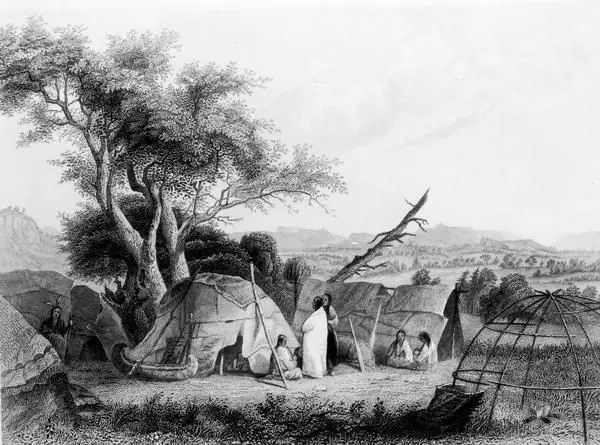
These settlements were unique, reflecting the indigenous peoples’ diverse cultures, languages, and traditions. Despite the challenges posed by European colonization, some elements of these settlements have survived to the present day, offering a vibrant window into the history of North America.
Cahokia – The Mississippian Metropolis
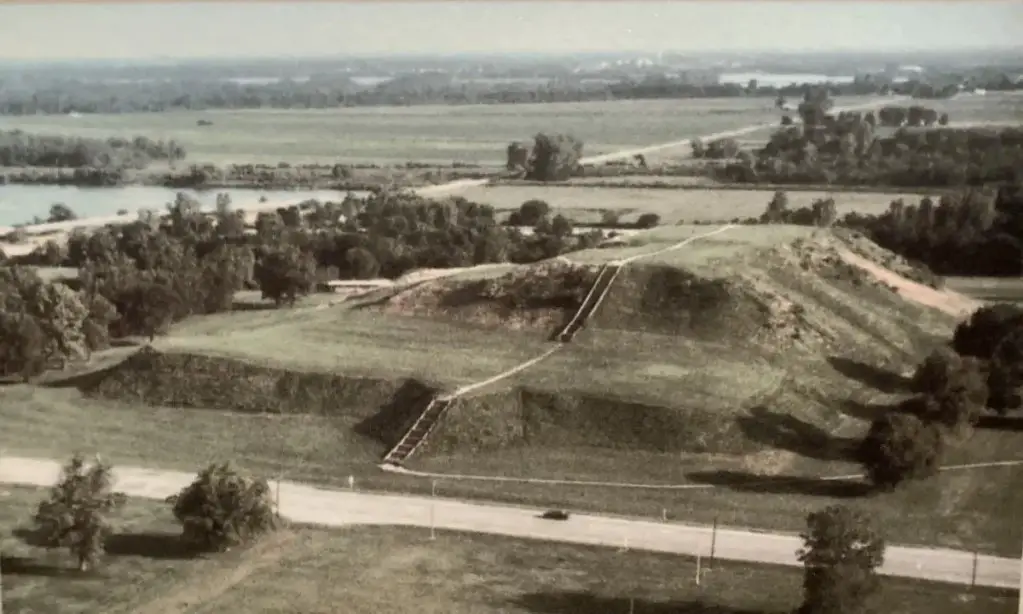
Cahokia was a large Native American settlement located near present-day Collinsville, Illinois. It was created by the Mississippian culture, a complex society that emerged in the Mississippi River Valley around 700 AD and lasted until the arrival of Europeans in the 16th century.
Cahokia was one of North America’s largest and most influential indigenous settlements and was part of a network of significant settlements stretching from the Great Lakes to the Gulf of Mexico. At its peak, it is estimated to have had a population of around 20,000 people, making it one of the largest cities in the world at the time.
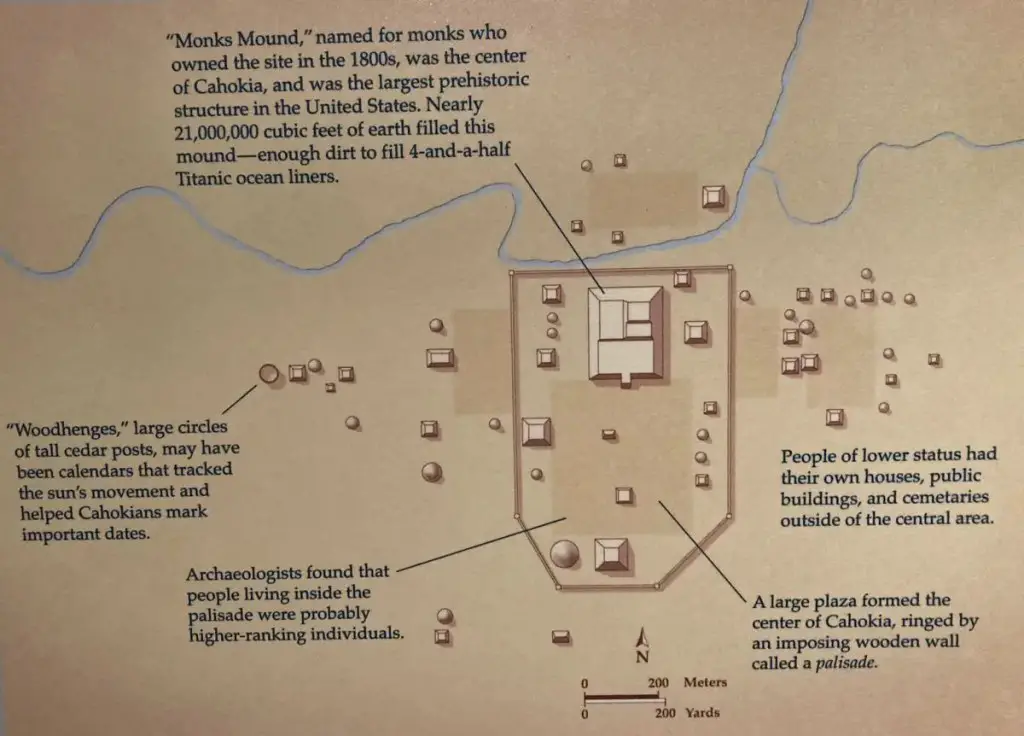
Cahokia was a center of trade and commerce for the indigenous peoples of the Mississippi River Valley. It was an important hub in a network of trade that extended across North America. The people of Cahokia traded a wide range of goods, including furs, food, textiles, and goods made from stone, copper, and other materials. They also traded in jewelry, precious metals, and pearls.
Today, Cahokia is a cultural and historical site, and it is thought to be one of the most important archaeological sites in North America. The settlement remains are now part of the Cahokia Mounds State Historic Site. Visitors can learn about the history and culture of the indigenous peoples of the Mississippi River Valley and the vital role that Cahokia played in their lives.
Learn More: The Mystery Of Michigan’s St. Joseph Indian Trail
Michilimackinac – The Trading Center On The Straits
Michilimackinac was a Native American settlement on what is today called Mackinac Island. (as opposed to the fort today named Fort Michilimackinac near where Mackinaw City, Michigan, is now.) It was at the Straits of Mackinac. It was built by the Anishinaabe, who are also called Ojibwe or Chippewa. It was one of the largest and most important Native American settlements in the Great Lakes area.
Michilimackinac was built in the late 1600s or early 1700s, and it quickly became a major center of trade and culture for the native peoples of the Great Lakes region. It was part of a network of significant settlements that stretched from the Great Lakes to the Mississippi River.
Michilimackinac was a center of trade and commerce for the indigenous peoples of the Great Lakes region, and the people of the settlement traded a wide range of goods, including furs, food, and textiles. They also traded with other indigenous peoples and with European explorers and traders, who began to arrive in the area in the late 1600s.
Today, the legacy of Michilimackinac and the indigenous peoples of the Great Lakes region lives on, and the Mackinac State Historic Parks preserve the history and culture of the area, including the remains of the settlement. Visitors can learn about the important role that Michilimackinac played in the lives of the Great Lakes region’s indigenous peoples and the area’s rich cultural heritage.
Bahweting – Precursor To One of the Oldest Citys in the US
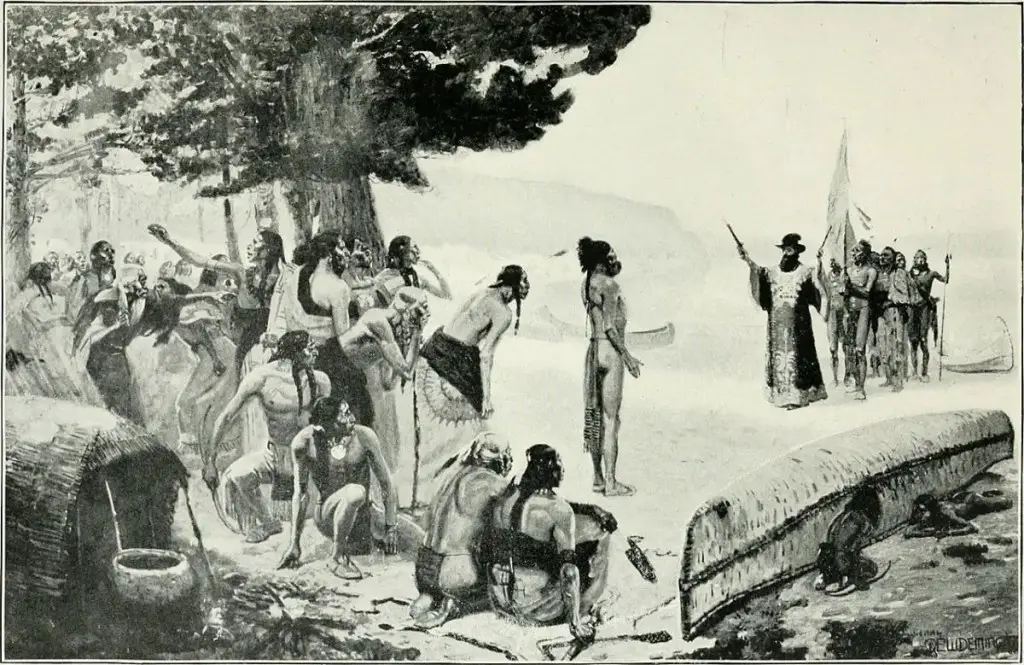
Bahweting, also known as The Gathering Place, was a Native American settlement near present-day Sault Ste. Marie, Michigan. It was created by the Anishinaabe (also known as Ojibwe or Chippewa) and was one of the largest and most important indigenous settlements in the Great Lakes region.
Native Americans, as well as other tribes from all over the area, migrated here during the spring and fall fishing seasons because the river below the rapids offered an abundance of fish. Although Bahweting was considered a seasonal community, the original inhabitants lived there permanently in lodges made of wood poles covered in bark or animal hides.
French missionaries and fur traders first entered this region in the 1600s. The place became known as Sault du Gastogne by the traders. The first “city” in the Great Lakes region was christened Sault Ste. Marie in 1668 in honor of the Virgin Mary by the illustrious Jesuit missionary and explorer Fr. Jacques Marquette.
Today, the legacy of Bahweting and the Anishinaabe people lives on, and the Sault Ste. Marie Tribe of Chippewa Indians is working to preserve the area’s history and culture, including the settlement’s remains. Visitors can learn about the important role that Bahweting played in the lives of the Anishinaabe people and the area’s rich cultural heritage.
Gichi Onigamiing – Lake Superior’s North Shore Portage Point
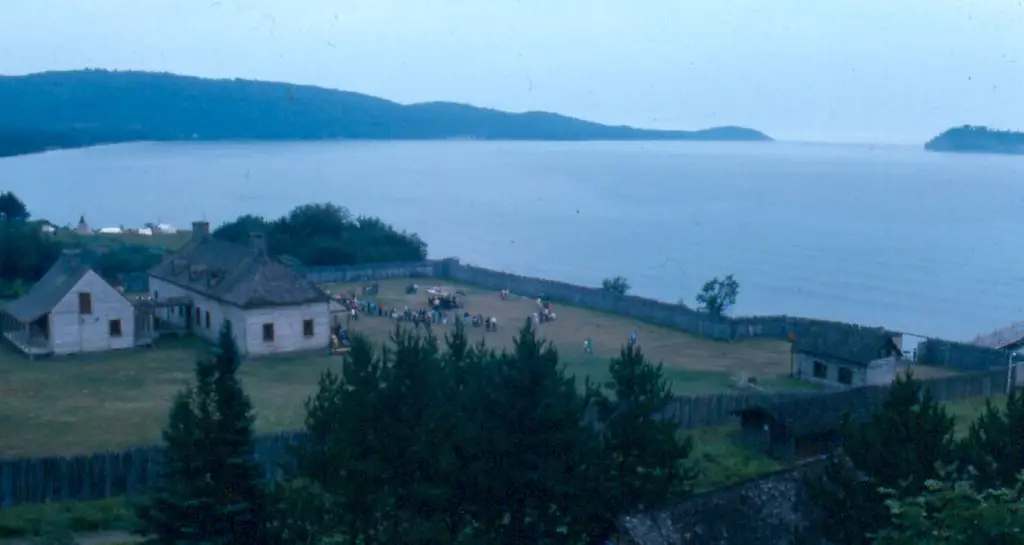
Gichi Onigamiing, also known as Grand Portage, is a historic seasonal migration route and the traditional site of an Ojibwe summer village on the northwestern shore of Lake Superior. In the 1700s, after voyageurs began to use it to carry canoes from Lake Superior to the Pigeon River, it became one of the most profitable fur-trading sites in the region and a headquarters for the North West Fur Company.
One of the most essential activities in Gichi Onigamiing was fishing. The region was located near Lake Superior and the North Shore of Minnesota, providing an abundant fish supply. The Ojibwe people also traded with other indigenous communities in the Great Lakes region, exchanging furs, hides, and foodstuffs.
With the arrival of European explorers and settlers in the late 1600s and early 1700s, Gichi Onigamiing and other Native American settlements in Minnesota faced significant challenges. As a result, the Ojibwe people were forced to relocate and were also impacted by introducing new diseases and disrupting their traditional trade and cultural practices. Nevertheless, the Grand Portage Band Of Lake Superior Chippewa continued to maintain their cultural traditions, and today, they are recognized as an important part of the cultural heritage of Minnesota.
Learn More: Michigan Indian Villages And Sites In Huron County
Saginaw – A Cluster of Communities
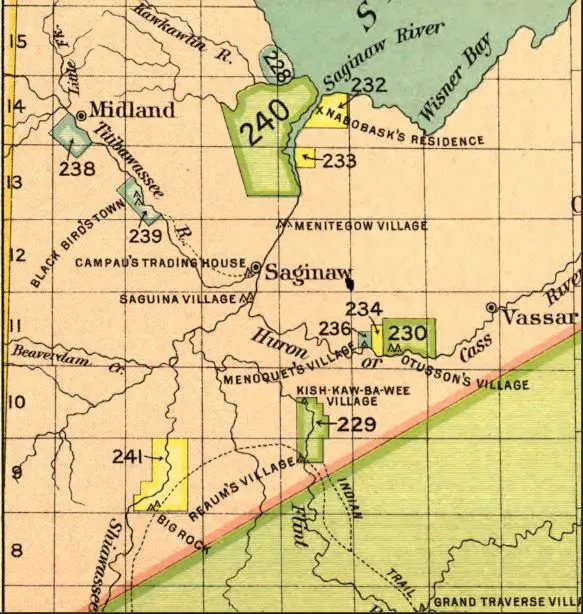
Before European exploration, there were numerous Native American settlements located near present-day Saginaw, Michigan, that were inhabited by members of the Anishinaabe (also known as Ojibwe or Chippewa) and the Sauk and Fox tribes. This settlement was known as Saginaw, and it was a hub of trade and culture for the indigenous peoples of the Great Lakes region.
The area was crossed by many rivers, which allowed the trading of a wide range of goods, including furs, food, and textiles. The settlement was also a center of indigenous culture and politics, and the Anishinaabe, Sauk, and Fox peoples maintained although these tribes may compete for hunting and fishing resources and conflicts and wars did arise.
Saginaw and the Anishinaabe were paid tribute by Alexis de Tocqueville’s famous story of his travel to Saginaw from Detroit in 1836. A Fortnight In The Wilderness, in what today’s terms, would be the ultimate road trip. Namely, traveling overland from Detroit to the last “white” settlement in the Northwest Territories, to Saginaw, Michigan.
Today, the legacy of Saginaw and the indigenous peoples of the Great Lakes region lives on, and the Saginaw Chippewa Indian Tribe continues to be an important part of the area’s cultural heritage. The federal government recognizes the tribe, and it works to preserve its cultural traditions and maintain its political and economic ties to the land.
Learn More: 2 Short Stories Of Anishinaabeg History In Saginaw Valley
Hochelaga – Gateway to the Atlantic
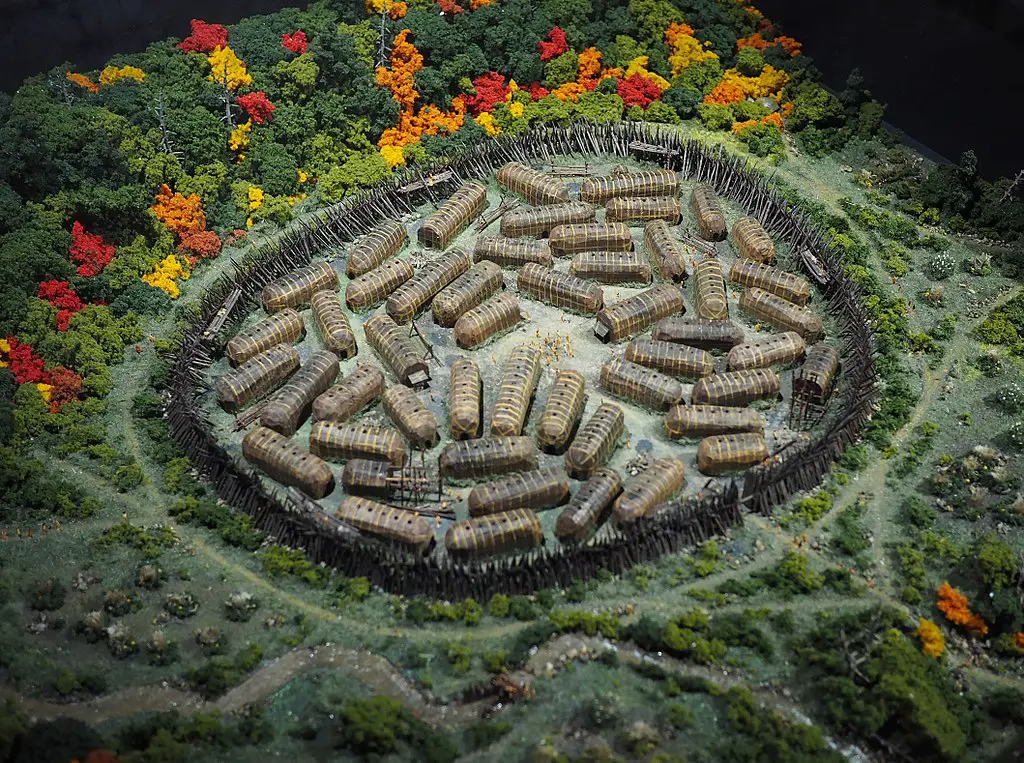
Hochelaga was a Native American settlement located near present-day Montreal, Canada. It was a Huron-Wendat settlement and one of the largest indigenous settlements in the Great Lakes region.
Hochelaga was established around the late 1400s and was a hub of trade and culture for the indigenous peoples of the Great Lakes region. The Huron-Wendat people maintained close ties with other indigenous groups, including the Iroquois and Algonquin, and were part of a larger network of settlements that stretched from the Great Lakes to the St. Lawrence River.
In terms of trade, the Huron-Wendat people at Hochelaga traded a wide range of goods with other indigenous groups in the Great Lakes region, including furs, food, and textiles. They also traded with European explorers and traders, who began to arrive in the area in the late 1500s.
Today, the legacy of Hochelaga and the Huron-Wendat people lives on, and the site of the settlement is considered one of the most significant archaeological sites in Canada. Despite the destruction of much of the settlement over the centuries, ongoing research and excavation is helping to shed light on the rich history and culture of the Huron-Wendat people and the important role that Hochelaga played in their lives.
Learn More: Michigan Indian Chief Standing Oak Defeated The Fox Tribe Near Sebewaing
Kekionga – Strategic Travel Point For Trade To the West
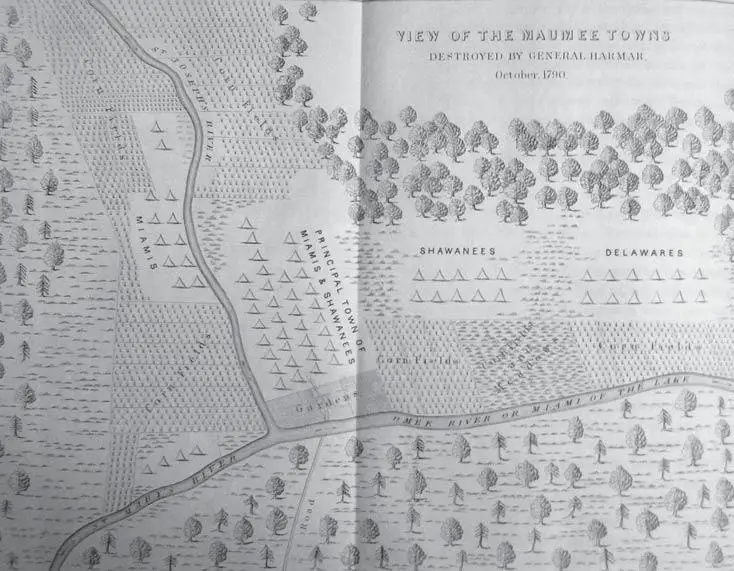
Kekionga was a Native American settlement located near present-day Fort Wayne, Indiana. It was founded by the Miami people, a tribe of the larger Algonquin-speaking peoples in the region.
Its name referred to the abundance of blackberries in the region and was located in the most expansive brier patch in the area. Because Kekionga was on the six-mile portage between the Maumee and Little rivers, which linked Lake Erie to the Wabash River and Mississippi River, it was a natural place for Europeans to set up a central trading post.
Regarding trade, Kekionga was a major center for exchanging goods between indigenous groups in the region, including furs, food, and textiles. The Miami people also traded with European explorers and traders, who began to arrive in the area in the late 1600s
The Miami Tribe of Oklahoma now stands for the surviving members of the once-large nation in the Great Lakes. According to the terms of the 1840 Treaty, the Miami Tribe was to be relocated to areas beyond the Mississippi. About 500 members of the tribe were herded at gunpoint in October 1846 and forced into canal boats to start the arduous voyage from eastern Indiana to the Ohio River via the Erie Canal system.
Steamboats were needed to convey the tribe further west, over Westport Landing in Kansas City, down the Ohio River to the Mississippi, up to Missouri, and across the Missouri River to the Mississippi. From there, the Miami traveled south on horses and wagons to a reserve set aside for them in the Kaw people’s territory, close to present-day La Cygne, Kansas. Until the Treaty of 1867 required their evacuation once more, this time to the Indian Territory now known as Oklahoma, the Miami remained in Kansas. Less than 100 adults made up the Miami Nation when they first arrived in the Indian Territory.
Learn More: The Horrid History Of 3 Indian Boarding Schools In Michigan
Waganagisi – Miles of Settlements on the Shore of Lake Michigan

Waganagisi, also called L’Arbre Croche, was an Odawa village in the 1700s. It was on the northern shores of what is now Michigan. The settlement was situated near the site of a natural harbor and was a major hub of trade, culture, and political power for the Odawa people.
The Odawa people have lived in the Great Lakes region for thousands of years, and Waganagisi was one of the largest and most important of their settlements and was said to span from Harbor Springs to Cross Village in present-day Emmet County, Michigan. It was a center of trade, with the Odawa people exchanging goods with other indigenous groups and French and British traders. The Odawa people were known for their extensive trade network, which extended from the Great Lakes to the Mississippi River and beyond. They traded a wide range of goods, including furs, food, and textiles.
In the 1660s and 1670s, the French established a trading post at Waganagisi, and the settlement became a center of French influence in the Great Lakes region. The French named the settlement L’Arbre Croche, which means “the crooked tree,” due to a large tree that was bent over near the harbor. The settlement became a key center of French power in the region, and the French and Odawa people maintained close political and economic ties.
Despite its importance, Waganagisi faced numerous challenges over the centuries. The settlement was destroyed by fire in the late 1600s, and the Odawa people faced attacks from other indigenous groups, as well as from European colonizers. Throughout this time, the Odawa people were forced to move their settlement several times, but they always maintained their cultural and political ties to the land.
Today, Waganagisi is remembered as an important center of Odawa culture and history. The settlement is considered one of the earliest examples of a successful indigenous-European trade relationship, and it has been recognized as a significant cultural and historical site by the state of Michigan. The Little Traverse Bay Bands of Odawa Indians continue to live in the Great Lakes region, and they remain an important part of the region’s cultural heritage.
Waganagisi was a major Odawa settlement that played a significant role in the cultural, economic, and political history of the Great Lakes region. Despite the challenges that the Odawa people faced, they maintained their cultural and political ties to the land, and today Waganagisi is remembered as an important center of Odawa culture and history.
The Legacy of Native American Settlements in the Great Lakes Region
The Native American settlements of the Great Lakes region have left a lasting legacy in North America, both in terms of the rich cultural heritage of the indigenous peoples who lived there and in the broader historical context of the region. Despite the challenges posed by European colonization, the descendants of these settlements continue to thrive and maintain their unique cultural traditions and practices.
Through cultural events, museums, and other cultural institutions, the legacy of these settlements lives on, and their importance to the history of North America continues to be recognized and celebrated. Whether through the ongoing struggles for indigenous rights, the preservation of historical sites, or the celebration of the vibrant cultures of these communities, the Native American settlements of the Great Lakes region will continue to play a critical role in shaping our understanding of the rich history and cultural heritage of North America.



